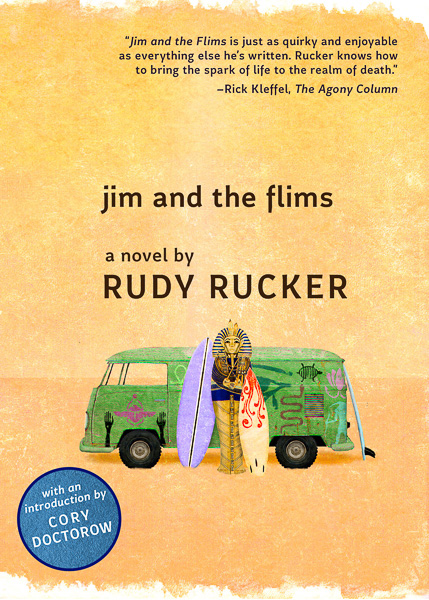|
Jim and the Flims, by Rudy Rucker
Jim and the FlimsPaperback: Night Shade Books, September, 2019, 3rd Edtion, with an introduction by Cory Doctorow. Buy a paperback or ebook of Jim and the Flims. Browse Jim and the Flims as a free webpage. SummaryA mind-blowingly gnarly surfing SF novel. Jim and the Flims is set in Santa Cruz, California . . . and in the afterlife. Jim Oster ruptures the membrane between our world and afterworld (a.k.a. Flimsy), creating a two-way tunnel between them. His wife is killed in the process. And now Jim faces an invasion of the Flims—who resemble blue baboons and flying beets. Aided by a posse of Santa Cruz surf-punks, Jim plunges into a mad series of adventures in the underworld—where he just might find his wife. Jim and the Flims is like classic myth retold for the 21st century. Except that it's funny. ReviewsJim and the Flims is a wild psychedelic romp that recasts the myth of Orpheus and Eurydice in the 21st century surf-punk/slacker world of Santa Cruz and its eartly and extra-earthly environs. Hilarious, profound, visionary, and genuinely moving, it vaults to the top spot on my list of favorite Rudy Rucker novels... A key component of Rucker's genius, it seems to me, lies in his ability to tackle his subjects on a multitude of levels simultaneously. There's a fractal beauty to it. If you're just into a weird and funny story, you've got it. If you dig mythic resonance—look no further. If theoretical physics is your bag, Rucker's witty allegories will delight you. Philosopher, Phil Dick fan, armchair theologian: there's something to challenge, satisfy, and delight any alert, intelligent reader. Jim and the Flims offers Rucker’s delightfully eccentric and transrealist approach to what turns out to be a kind of modern-day Orpheus tale. It’s often silly and lighthearted, but it’s buoyed by the emotional weight of Jim’s quest, and also by the often beautiful and moving view of life and death. And I can guarantee that it’s probably not at all like anything else you’re going to read this summer. The parallel world kicks in around Santa Cruz's northern city limits, the defining line of the duality, the boundary between order and chaos, truth and fiction, professorial normalcy and freaky chemical mentalbrain stuff, worldly secularity and Egyptian gods, Los Gatos/Silicon Valley and the Continent's edge, life and afterlife. And when the line's porous, the paradox, rather than crumbling, becomes even more pronounced. Jim and the Flims is a perfect showcase for Rudy Rucker's ability to craft a story that is both totally familiar and absolutely like nothing you've ever read before. ... Rucker's ability to create ordinary characters who must confront the extraordinary makes this book quite accessible to anyone willing to stroll on the beaches of Santa Cruz, check out the weird surfers and take in the gorgeous sunset. ... As Rucker's novel shows us, everyday life is weirder than we think and filled with more hope than we might expect. I love Rudy Rucker. The guy is simply incomparable when it comes to writing science fiction, managing to seamlessly blend highly intelligent existential and scientific speculation with wildly satirical and insanely imaginative plotlines... In this novel, Rucker reimagines the myth of Orpheus as only he can – Jim Oster is a former surfer dude, part-time stoner, and current Santa Cruz mailman who dabbles in high-tech research. Jim and the Flims...Rudy Rucker's weirdest, craziest, colorfulest book yet? That's saying a lot, I know. But when it is at its most bizarre, it is also most hilarious. Nobody else writes like Rudy. Rudy Rucker should be declared a National Treasure of American science fiction. Rucker puts the weird in science. String theory might as well have been invented to give rise to mind-benders like Postsingular. Rudy Rucker writes like the love child of Philip K. Dick and George Carlin. Brilliant, frantic, conceptual, cosmological... like lucid dreaming, only funny. Everything Rudy Rucker writes make you look at reality a little bit differently. From the AuthorOn July 1, 2008, I had a brain hemorrhage. I was gone for day or two—it was like dying and being reborn. A very strange experience. It took me a couple of months to get my head back together. Naturally, being a writer, I wanted to write something inspired by my trip to the underworld. I ended up writing two books. The first of these became my autobiography, Nested Scrolls. And the second book became Jim and the Flims, a somewhat fantasy-like SF novel about a man who nearly dies and then, although still living and fully recovered, travels into the afterworld to deal with some potentially Earth-destroying beings called flims. Also he’s on a mission to bring back dead wife back from the underworld—it’s kind of an Orpheus and Eurydice tale. Another influence was a series of surfing SF stories I’ve written with Marc Laidlaw over the years. These stories are somewhat humorous—and this attitude carries over to Jim and the Flims. I particularly liked the scene with a stoner surfer attempting to get high off the smoke from ancient Egyptian mummy that he’s gotten hold of… MoreNotes for Jim and the Flims, is a free booklength PDF file with links and illos. See notesforjimandtheflimsposted.pdf. You can download it or read it online. When I'm working on a novel, I often make paintings to help me visualize the upcoming scenes. I made nine paintings while working on Jim and the Flims—rather a lot of them, even for me. I'll put images of them here along with comments. Some of my paintings are available for purchase, you can check them out on my Paintings page. Surf Pilgrim At the Core of the World |
